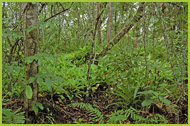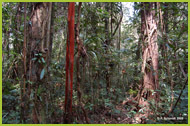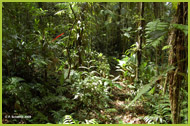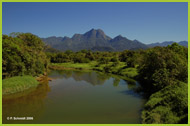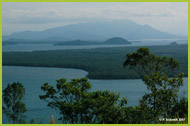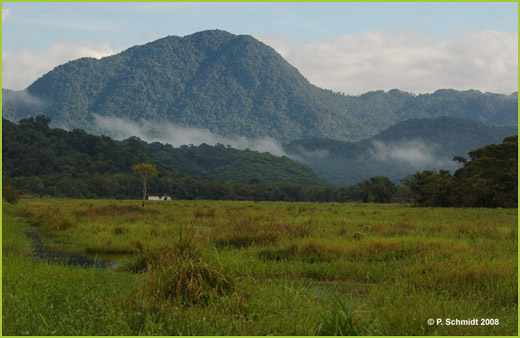Region
Forests on the coast of the Brazilian state of Paraná, in which the investigations of the SOLOBIOMA - project take place, are part of the largest contiguous areas of preserved forest in the Mata Atlântica.
Located in the transition region from the tropics to the subtropics, the forests range from beaches, where they grow on sandy Podzols (superficially washed out soils with illuvial horizon) via groundwater-influenced Gleysols in the coastal plains up into the coastal mountains, where they stock on Cambisols (less-developed brown soils). Nutrient contents and the physical-chemical structure of the soils determine the living conditions for soil organisms, the growth conditions for plants, the vegetation structure and -dynamics and, finally, both the land use and the regenerative capacity of forests.
Due to their vegetation, most of the forests along the coast are classified as 'dense ombrophilous Atlantic forest' and further subdivided into lowland, submontane and montane forests.
Another forest formation is the unique coastal 'Restinga' forest growing on Holo- and Pleistocene sandy soils. In Paraná they are reduced to less than 10% of their original stockings.
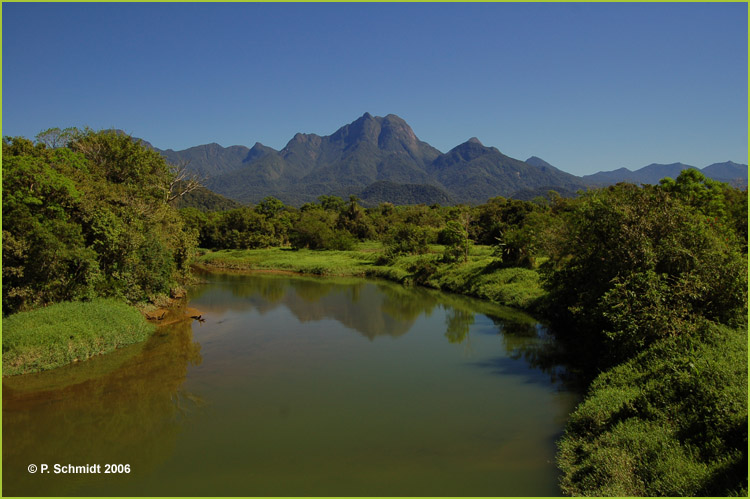
Part of the 'Cachoeira Reserve'
Investigation areas
Investigation areas are located in different areas of the coastal region of Paraná about 100 km away from the capital city Curitiba. They can be divided into five regions, lying 30 to 100 km apart:
- Cachoeira
- Itaqui
- Palmito
- Rio Pequeno
- Batuva
Diversity studies were primarily carried out in the two reserves 'Cachoeira' and 'Itaqui' owned by the SPVS, both located in the environmental protection area (EPA) of Guraqueçaba.
The distance between the two reserves is approximately 35 km. The reserve Itaqui is located near the village of Tacaçaba and is assigned to the community of Guraqueçaba while the Reserve Cachoeira belongs to the community of Antonina.
Within the reserves, four different stages were selected with regard to their forest regeneration after grazing: H: < 8 years, A: 15-20 years, M: 35-50 years, F: > 100 years after grazing.
In each forest stage in the so-called 'dense ombrophilous Atlantic submontane forest' three replicates à 30 m x 50 m were created, 12 sites in each Reserve (24 sites in total) were sampled.
During the first phase of the project pastures were also included in the studies and furthermore a comparison of sites on Cambisol with sites on Gleysol was accomplished. In the second project phase only forest areas stocking on Cambisols were investigated.
Functional studies have been largely carried out in three different regeneration stages (20, 33 and 58 years after abandonment of cultivation) of a Restinga Forest in which the Brazilian partner institution is already working for several years.
The so-called 'Floresta Estadual do Palmito' with a total size of 530 ha, is administered by the Environmental Institute of Paraná IAP and is situated in the municipality of Paranaguá (25o35'S, 48o32'W). The so-called 'dense ombrophilous Atlantic forest of the Lowlands', occurring in this area, is growing on sandy Podzols, which can be classified as not hydromorphic in the experimental sites. For a comparison with the diversity studies, three additional sites with the same criteria were established in the Cachoeira reserve.
Experimental sites (30 m x 50 m) in agricultural systems were on the one hand installed in areas of small holders in the region of Rio Pequeno, located in the proximity of the Cachoeira reserve, and on the other hand, in the small village Batuva, near the border of the State of São Paulo. In Rio Pequeno three Banana monocultures and three mixed cultures of banana with Euterpe edulis were investigated. In Batuva three areas with different densities of Euterpe were studied and a mulch experiment was installed in an Euterpe-monoculture.
